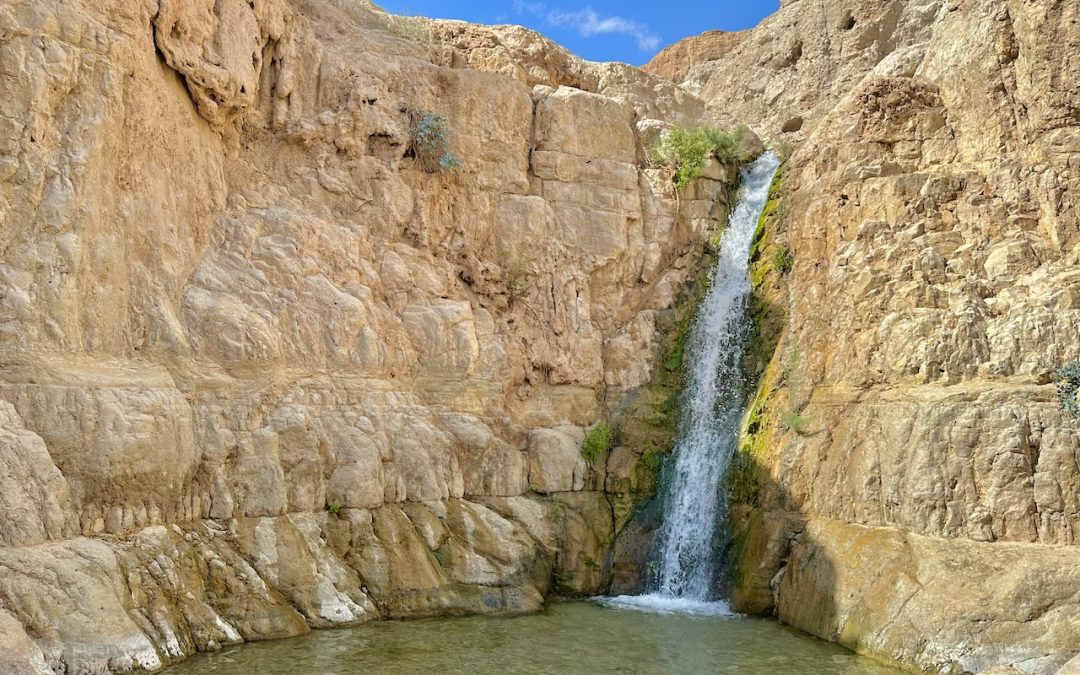Day 9 – Saturday, November 15: Masada, Ein Gedi, Qumran, Judean Desert, Jericho
We left the hotel at 7:45 this morning following a “Shabbat”breakfast. Today was “desert day” here in the Judean Desert. The weather was actually overcast most of the day (unique for the Dead Sea area), with breaks of sun throughout the day. We even had a few showers towards the end of the day. We read Psalm 18:1-2 as we left the hotel, focusing on the word the Hebrew word metzada (“fortress”).
Masada
The site of Masada (metzada, in Hebrew) was our first site and only a 15 minute drive from our hotel. This was built in the early 30s BC as a palace-fortress by Herod the Great. We took the cable car to the top and began seeing the ruins from the 1st century. We saw huge cisterns, the western and northern palaces, the Roman Ramp, the synagogue, and the bathhouse. In 70 AD, this was the location where 967 Jews found refuge from the Romans following the destruction of the Temple. The holdout lasted about three years until all by five of these Jews (a few women and children) took their own lives. It is a story of bravery and courage! Nine in the group walked down the Snake Path. It took a little over 30 minutes.
Ein Gedi
From here we drove about 20 minutes north of Masada to get to Ein Gedi, one of only a few oasis here in the edge of the Judean Desert. We read from Song of Songs 1, 2 Chronicles 20 (the “Ascent of Ziz”) and 1 Samuel 24 (David hid from Saul here). Since the flash flood this past Spring causing the trail to be unsafe, we could only walk back to the first water falls. It was still beautiful to see this and the canyon beyond.
Qumran
Qumran is the most important site in Israel because of what was discovered here! When we arrived, we walked directly to the cliff area of the desert to get a glimpse of Cave 6 (one of 12 caves in which fragments of ancient scrolls were discovered). We also saw the beginning of the aqueduct system that brought rain/flood water into the site.
It was here at Qumran where the Dead Sea Scrolls were found! The discovery began in 1947, while the excavation took place through 1956. We walked through the limited ruins where a small community of Essenes lived (or retreated here from Jerusalem, as a new theory suggests). To date, about 930 scrolls and fragments of texts scrolls have been discovered. The scrolls/texts date primarily from the late 3rd century BC – 1st century AD. At the small archaeological site we saw cisterns, ritual baths (mikvot), and the scriptorium. We read from the Essenes’ “Nine Beatitudes” text (“Blessing are you …” it sounds very similar to Jesus’ “Nine Beatitudes.” In front of “Cave 4” (where the majority of texts were found), we read from “Psalm 151,” and Psalm 19. We celebrated the perseverance of God’s Word! We were invited to take joy in God’s Word.
ho, we visited the site of “New Testament” Jericho. Specifically, we look down upon the winter palace of Herod the Great from an older Hasmonean tower. Herod the Great died here in 4 BC (some suggest 1 BC), and his body was transported to Herodoum (9 miles SE of Jerusalem) for burial.
We drove back to our hotel in Ein Bokek for dinner and our second overnight here. Tomorrow we end the day at our hotel in Tiberias where we will enjoy three nights!
“Today was “desert day!” We visited sites located along the Dead Sea and on the edge of the Judean Desert. Masada, Ein Gedi, and Qumran were all great sites to visit. We ended with Jericho where the walls came ‘tumblin’ down’.”

Jericho
Next, we drove into Jericho. We walked to the archaeological site of Old Testament Jericho, Tel es-Sultan. After we climbed the site. We looked east and could see the Jordan Valley the Mt. Nebo on the ridge on the horizon (Dt. 34). Elijah was taken to heaven in the area across the river (2 Kings 2). Jesus was baptized in the Jordan River at “Bethany Beyond the Jordan” (John 1). Looking south we could see the area of NT Jericho (where Zachaeus and Bartimeaus lived, and where Herod the Great died in 4 BC). We then turned our attention to the ancient OT site of Jericho. The archaeology of this ancient site of Jericho supports and confirms the Bible’s historicity. Besides seeing the oldest structure (a round tower) in Israel, on the southern end we saw the double retaining walls of this Canaanite city taken my Joshua (Joshua 6). A mud brick wall once stood on top of these stone walls. This wall was the wall that came tumblin down.
While still in the area of Jericho, we visited the site of “New Testament” Jericho. Specifically, we look down upon the winter palace of Herod the Great from an older Hasmonean tower. Herod the Great died here in 4 BC (some suggest 1 BC), and his body was transported to Herodoum (9 miles SE of Jerusalem) for burial.
We drove back to our hotel in Ein Bokek for dinner and our second overnight here. Tomorrow we end the day at our hotel in Tiberias where we will enjoy three nights!
Day 10 – Sunday, November 16: Jericho, Shiloh, Beth Shean, Mt. Gilboa, Tiberias









